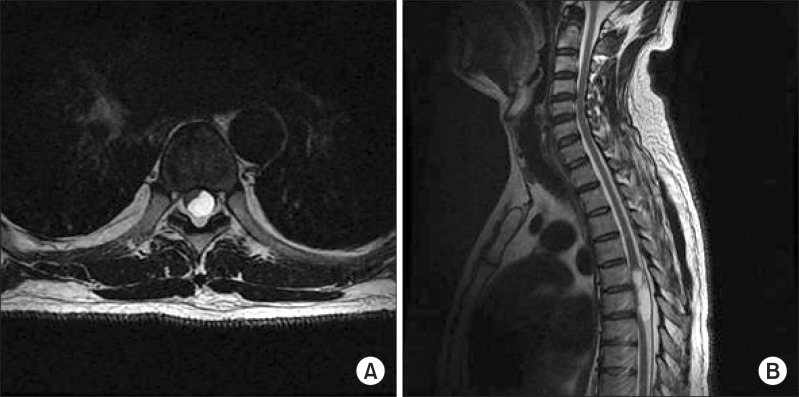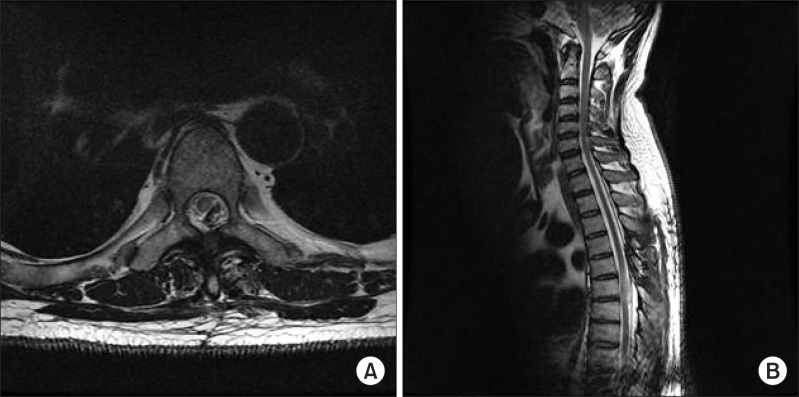Ann Rehabil Med.
2014 Apr;38(2):273-276.
Inexplicable Abdominal Pain due to Thoracic Spinal Cord Tumor
- Affiliations
-
- 1Department of Rehabilitation Medicine, St. Paul's Hospital, The Catholic University of Korea College of Medicine, Seoul, Korea. petitlac@naver.com
Abstract
- Chronic, refractory abdominal pain without a metabolic or structural gastroenterological etiology can be challenging for diagnosis and management. Even though it is rare, it has been reported that such a recurrent abdominal pain associated with radicular pattern can be derived from structural neurologic lesion like spinal cord tumor. We experienced an unusual case of chronic recurrent abdominal pain that lasted for two years without definite neurologic deficits in a patient, who has been harboring thoracic spinal cord tumor. During an extensive gastroenterological workup for the abdominal pain, the spinal cord tumor had been found and was resected through surgery. Since then, the inexplicable pain sustained over a long period of time eventually resolved. This case highlights the importance of taking into consideration the possibility of spinal cord tumor in differential diagnosis when a patient complains of chronic and recurrent abdominal pain without other medical abnormalities.
Keyword
MeSH Terms
Figure
Reference
-
1. Eeg-Olofsson O, Carlsson E, Jeppsson S. Recurrent abdominal pains as the first symptom of a spinal cord tumor. Acta Paediatr Scand. 1981; 70:595–597. PMID: 7315307.
Article3. Buck E, Bodensteiner J. Thoracic cord tumor appearing as recurrent abdominal pain. Am J Dis Child. 1981; 135:574–575. PMID: 7234798.
Article4. Calmels P, Mick G, Perrouin-Verbe B, Ventura M. French Society for Physical Medicine and Rehabilitation (SOFMER). SOFMER). Neuropathic pain in spinal cord injury: identification, classification, evaluation. Ann Phys Rehabil Med. 2009; 52:83–102. PMID: 19909700.5. Eleftheriadis N, Papaloukas C, Eleftheriadis D, Pistevou-Gompaki K. Upper gastrointestinal complaints as a consequence of thoracic spinal tumor. Acta Gastroenterol Belg. 2005; 68:388–391. PMID: 16268430.6. Neinstein LS. Abdominal and flank pain as presenting symptoms of schwannoma. J Adolesc Health Care. 1989; 10:143–145. PMID: 2522428.
Article7. Kato M, Nakamura H, Terai H, Konishi S, Nagayama R, Takaoka K. Why does delay exist in the diagnosis of intradural spinal cord tumor despite the availability of MRI? J Clin Neurosci. 2008; 15:880–885. PMID: 18539463.
Article8. Robertson PL. Atypical presentations of spinal cord tumors in children. J Child Neurol. 1992; 7:360–363. PMID: 1469242.
Article
- Full Text Links
- Actions
-
Cited
- CITED
-
- Close
- Share
- Similar articles
-
- A Case of Spinal Cord Tumor (A-V Malformation): as Unusual Cause of Anginal Chest Pain
- Atypical Abdominal Pain
- Spontaneous Herniation of the Thoracic Spinal Cord: A Case Report
- Spinal Schwannoma in a Patient with Chronic Right Flank Pain Presenting at an Emergency Department
- Hydrocephalus Associated with Spinal Cord Tumor: Report of a Case



